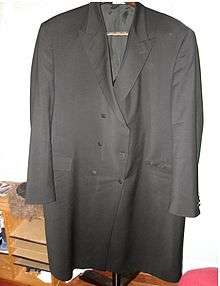Rekel

Rekel (Yiddish: רעקל) or Lang Rekel (plural rekelech) is a type of coat worn mainly by Hasidic Jewish men during the Jewish work-week (Sunday-Friday).
The word 'Rekel' stems from the German-dialect word 'Röckel' = high-German 'Röckchen' = grammatical diminutive of 'Rock' = male long-coat (not to be confused with the female 'Rock' which is a skirt). Note that the Yiddish dialects are abundant with the use of such grammatical diminutives, in contrast to high-German in which diminutives are used only rarely and in specific situations. The phonetic transition from 'Röckel' to 'Rekel' is due to the difficulty for Eastern European speakers to pronounce the German Umlaut-vowel 'ö'.
Rekelech are generally made of a black or navy wool blend or of worsted wool. Today some are made of 100% polyester. Many Hasidim in the past did not wear wool clothing, and the new polyester rekelech actually make it easier to keep this old custom. They tend to be light, and thinner than the average suit coat, since they are generally worn throughout the year. Rekelech are usually sold as part of a suit with matching pants and a vest (waistcoat, זשילעט), though they are also sometimes available as suit separates.
The most common type of rekel is the double-breasted variety, but many other styles exist. These include a single-breasted version (typical of the Breslover Hasidim), and concealed button version, which many Gerer, Bobover and Sanz-Klausenburger Hasidim wear. There is also a single breasted version with a shawl collar and attached gartel. Several styles of unlined rekelech exist, which are typically worn in hot weather, and often conform to the styles noted above. All rekelech share a right over left button style, the opposite of what one would find on most men's clothing. Unlike most long coats rekelech tend not have walking vents, but some of the concealed button and single-breasted rekelech do.
As with most Haredi Jewish clothing today, rekelech may be darkly colored; black and navy blue are favorite color choices. Prior to World War II the most popular color for the rekel was a light grey, but this has fallen into disuse. Pinstripes have always been a common feature on rekelach. In recent times, rekelech with other patterns such as embossed checkers have caught on, particularly with the more colorful Breslov, Bobov, and Sanz-Klausenbug Hasidim. The rekelekh of these groups also tend to use lighter colors than those of other Hasidim, ranging anywhere from black to lighter shades of midnight blue.
Prior to the use of the rekel as standard Hasidic garb, Hasidic coats were generally buttonless, white robes with black or multi-color stripes, held together by a gartel. The change in Hasidic dress occurred towards the end of the 19th century, when the Jewish Emancipation became successful. The old style is still maintained by many communities in Jerusalem, even non-Hasidic ones.
Though the rekel was intended for weekday use, some Hasidim wear one on Shabbat. A proper Shabbat coat is called a bekishe in Hungarian. A bekishe is usually made of polyester or silk.
References
- Hammer, Joshua (From the magazine issue dated Nov 8, 1999). "A Tale Of Two Brothers" (Web). Newsweek. Retrieved October 10, 2008. Check date values in:
|date=(help)